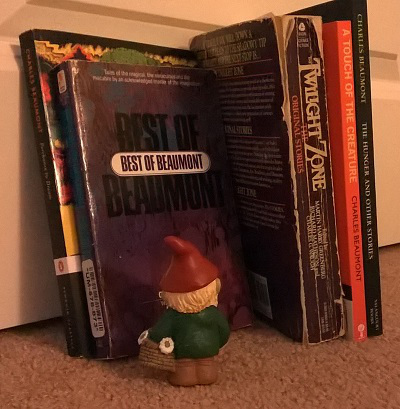
Beaumont(h) – Introduction
[Explanation of Reading Journal Entries/Ratings]
[264] “Night Ride” (1957)
Perchance to Dream
3.5 out of 5 stars.
The Plot:
A jazz group disintegrates when its members discover the deceit that brought them together.
Unlike “Black County” (Post 1, note [9]), the jazz-style of this one works extremely well. I don’t know what Beaumont’s doing differently but he learned something in the three years between the publication of the two stories. This one is good.
[265] Reference:
The kid swung into some chestnuts, like “St. James Infirmary” and “Bill Bailey.”
(p.293)
“(Won’t You Come Home) Bill Bailey”, originally titled “Bill Bailey, Won’t You Please Come Home?” is a popular song published in 1902. It is commonly referred to as simply “Bill Bailey.” Its words and music were written by Hughie Cannon (1877 – 1912), an American songwriter and pianist. It is still a standard with Dixieland and traditional jazz bands.
[266]
Davey Green wasn’t what you’d call a virtuoso, exactly. He didn’t hit all the notes. Only the right ones.
(p.294)
[267]
“Do you know what jazz is? (…) I’ll tell you one of the things it is. It’s vocabulary. A way of saying something. You can have a small vocabulary or a large one. We have a large one, because we have a lot on our minds.”
(p.296)
[268] References:
“Some bands play Storyville, some play Lighthouse. (…) Sometimes we’ll spend a week kanoodling on the traditional, flip over and take up where Chico Hamilton leaves off.”
(p.296)
The Lighthouse Café is a nightclub located in Hermosa Beach, California. It has been active as a jazz showcase since 1949 and, under the name “The Lighthouse,” was one of the central West Coast jazz clubs from the 1950s through the late 1970s.
Chico Hamilton (1921 – 2013) was an American jazz drummer and bandleader. He came to prominence as sideman with the likes of Lester Young, Gerry Mulligan, Count Basie and Lena Horne. Hamilton then struck out as a bandleader and subsequently led a number of groups over the years.
[269] Reference:
Max closed the Bible and broke out some Catto’s scotch.
(p.297)
According to Catto’s site: “Crafted in Scotland since 1861. Enjoyed by the discerning during the golden age of ocean travel.”
[270] Reference:
He was damned young, maybe only twenty-five; handsome, in a Krupa kind of way.
(p.299)
Gene Krupa (1909 – 1973) was an American jazz and big band drummer, band leader, actor, and composer. Known for his highly energetic, flamboyant style and for his showmanship, Krupa is considered one of the most influential drummers in jazz history and one of the first major percussive soloists.
[271] Reference:
We did “Night Ride,” our trademark.
(p.300)
“Night Ride” is a semi-common song title. Herb Alpert has a pretty good “Night Ride“, but it was released in 2015.
I assume Beaumont created “Night Ride” as a title for a jazz standard for this story.
[272] Reference:
He got the nod from Max and started in on some sad little dancing on “Jada.” It isn’t easy to make that tune sad. He did it.
(p.300)
“Ja-Da (Ja Da, Ja Da, Jing, Jing, Jing!)” was a hit song written in 1918 by Bob Carleton. The title is sometimes rendered as “Jada.” Ja-Da has flourished through the decades as a jazz standard. (Here’s a performance by A Steam Jazz Band.)
[273] Reference:
Davey stopped, suddenly. Ten beat pause. And we thought it was over, but it wasn’t. He was remembering something else now, and I knew that that first was just the beginning.
He started a melody, no life in it, no feeling: Just the notes: “If you were the Only Girl in the World”- Then he smeared his fist down the keys and began to improvise. It was wicked. It was brilliant. And the cats all swallowed their ties.
(p.300)
“If You Were the Only Girl (In the World)” is a popular song written by Nat D. Ayer with lyrics by Clifford Grey. It was written for the musical revue The Bing Boys Are Here, which premiered in 1916 in London. It has become a standard, recorded by many artists including Doris Day (1953) and Barbara Streisand (1965).
[274] Reference:
Why did Woody Herman die for weeks in a Chicago pad and then move two blocks away and hit like a mother bomb? It just happens.
(p.301)
Woody Herman (1913 – 1987) was an American jazz clarinetist, alto saxophonist, singer, and big band leader. (I can’t find references to his popularity/start in Chicago.)
[275] References:
We got out of the Corn Belt fast, got booked into the Haig in L.A. and outpulled everything since Mulligan.
(p.301 – 302)
The Haig was a jazz club located in Hollywood (across from the Ambassador Hotel). Gerry Mulligan ran the Monday night jam night at the club. His first California band was formed at The Haig and maintained an eleven-month engagement there beginning in the spring of 1952.
It sounds like The Haig was popular in the 1950s. I don’t know when it closed.
[276]
Used to be he’d get mad as hell at the son of a bitch that took her breath out of her body and put her under ground; now he was mostly just sad, lonely, brought down.
(p.302)
[277]
We played for little chicks with thick glasses, thick chicks with little asses, and that drunk loser who kissed it all good-by.
Blues men.
(p.302)
[278] Reference:
Downbeat tagged us as “the most individual group in action today.”
(p.303)
Down Beat (stylized DOWN BEAT) is an American magazine devoted to “jazz, blues and beyond.” It was established in 1934 in Chicago.
[279] “Nursery Rhyme” (1957)
The Hunger
2.5 out of 5 stars.
The Plot:
Carlie flees the scene of a murder and seeks refuge with his estranged parents.
[280] Like “Miss Gentilbelle”, this story contains a “sick” mother who raised her child incorrectly (in this case, never accepting that he has aged past infancy) while the father allows the behavior. Compare the following with “Miss Gentilbelle” Post 5, note [193]:
“What’d I do to make her take on like that, hate me so?”
The old man shrugged. “You – growed up, boy.”
“They something sinful in that? What’d she expect me to do, stay a baby my whole life?”
“Your ma was a sick woman. I tried to tell you that! Does things to you to lose four young’uns – I don’t know. How would I know? I ain’t a woman. It was just like as if she wasn’t going to lose you any way, any way at all.”
“You think that was right? Fair?”
The old man bristled. “She’s a sick woman. Sick – can’t you get that through your brain!”
(p.135)
[281]
The house was filled with quiet, the quiet that comes when the boards are too old to squeak, when the clocks have all stopped ticking, when the air is clear and still outside.
(p.131)
[282]
The room glowed in the soft April moonlight, the cool silver light that came in through the open window. It took out shadows and left everything dim, as if seen from a great distance.
(p.131)
[283]
Eyes small, set well apart, but small and grey.
(p.132)
[284]
The door opened, flooding light.
A woman stood in the doorway, balanced on canes.
There were men behind the woman.
They had guns.
(p.138)
[285] “Open House” (1957)
The Hunger
5 out of 5 stars.
The Plot:
Eddie has just murdered his wife. And then company arrives.
An evil, tense comedy of errors that escalates into wonderful madness. My favorite Beaumont story.
[286]
Mr. Pierce froze. His head jerked up like the head of a feeding animal suddenly startled; then he recognized the sound and fear began to rearrange him, draining the blood from his head, stopping his throat, popping his heart up into his craw. He listened and watched his nerves and his courage and his future all eddy away, like rotted lace in a quick wind.
(p.65)
[287]
Mr. Pierce rose and looked at the bathtub. At the water that was not water any longer but, instead, bright red ink, burning red against the glistening white porcelain sides. At the pale things floating in the bright red water, the pale soft things, floating, drifting, turning, like pieces of lamb in a simmering stew.
(p.65)
[288] Translate:
“Wie Geht’s (…) Was ist los mit der gesundheit?”
(p.66)
German: How are you (…) What’s wrong with the health?
(If der is changed to dir, the translation becomes: What’s wrong with your health?)
[289] Reference:
It was Lew Hoover, in a soup-and-fish and a new mustache.
(p.66)
noun – (British; informal, dated) – men’s evening dress.
[290] Reference:
“I’ve always like Claudette Colbert.”
(p.67)
Claudette Colbert (1903 – 1996) was an American film actress and leading lady in Hollywood for over two decades. She won the Academy Award for Best Actress in It Happened One Night (1934).
[291] Reference:
“I wonder,” Fein said, dreamily, “what ever happened to Laird Cregar. There was a real actor.”
(p.68)
Samuel Laird Cregar (1913 – 1944) was an American stage and film actor. He was best known for his villainous performances in films such as I Wake Up Screaming (1941) and The Lodger (1944). He died of a heart attack at 31.
[292] Reference:
His Matisse “Odalisque.”
(p.70)
An odalisque was a chambermaid or a female attendant in a Turkish seraglio (sequestered living quarters used by wives and concubines).
Henri Matisse painted at least two works with “Odalisque” in the title: “Odalisque, Harmony in Red” (1926-27) and “Reclining Odalisque” (mid-1920s).
[293]
He then leaned over, took ahold of Emma’s legs and pulled hard. Her massive body shot forward in the tub. Mr. Pierce put one foot on her throat and pushed her head beneath the soapy water: she thrashed and squirmed and bubbled, and splashed, but soon it was quiet.
Then Mr. Pierce shook and trembled for almost half an hour.
(p.71)
[294] Translate:
“Kaput. Schluss.”
(p.71)
German: end; ending; conclusion.
[295]
No one else knew how he had hated her, he’d always been so polite. And if it were done a little at a time, just a little: parts in the freezer, put through the grinder, distributed to a hundred customers over a hundred days… who would notice?
(p.72)
Mr. Etchison (The Dark Country, note [27]): This is how you do a cannibalistic butcher story!
[296] Translate:
“Anyway, I feel a little sick. Sick. Verstay?”
(p.73)
I can’t find a meaning for this word. From context, it seems to mean, “You understand?”
[297]
[Mr. Fein] had taken no more than two steps inside the bathroom when he gasped, wheeled, gasped again and fell, clawing, to the pink tile floor.
Mr. Pierce steadied himself, removed from Mr. Fein’s neck the long thin knife used for trimming fat, and lifted and pulled and strained and at last managed to get the heavy figure into the bathtub.
Water sloshed over the sides, now, but it was not even like red ink any more, but deeper red, and gummy.
(p.75)
[298] “Perchance to Dream” (1958)
Best of Beaumont; Perchance to Dream; Twilight Zone Original Stories
2.5 out of 5 stars.
The Plot:
A nightmare continues every time Philip Hall falls asleep. He knows the next one will be his last.
One of Beaumont’s more faithfully adapted Twilight Zone episodes. “Perchance to Dream” has some plot/thematic similarities to Ursula Le Guin’s [Lathe of Heaven] and encountering “Perchance to Dream” first probably damaged my opinion of Le Guin’s book. I feel like Beaumont does as much with the dreamer/psychiatrist relationship in nine pages as Le Guin does in nearly two-hundred.
[299]
Running away won’t do you much good, will it?”
Hall hesitated.
“Forgive the cliché. Actually, running away is often the best answer. But I don’t know yet that yours is that sort of problem.”
(p.1)
[300] Reference:
“One night I heard a ghost story. ‘Hermit’s Cave’ it was called. All about a man who gets drowned and comes back to haunt his wife.”
(p.3)
The Hermit’s Cave was a syndicated radio horror series which aired from 1930 to 1944. Over 800 episodes were produced. The Hermit’s Cave was narrated by the character the Hermit.
Beaumont’s character may have heard an episode on The Hermit’s Cave about a drowning man. I can’t find which specific one that would have been.
[301] “The Philosophy of Murder” (unpublished until 2000 collection)
A Touch of the Creature
1 out of 5 stars.
The Plot:
Professor James Morley tells the tale of teenager Mary Ross’ murder.
[302] The terrible quality of this story is purposeful: it’s a drunken stream-of-consciousness by a guilt-stricken man. But we don’t know that until the end. If this was the first story of Beaumont’s I came across, I would have assumed the man couldn’t write.
He should have framed both ends of the story with the party scene, to give the reader context. Starting a third-person story with terrible writing is a dangerous move.
She became frightened again when she remembered that her parents were spending the night at the Johnsons’ and wouldn’t be back until late the next evening. Jim Johnson and his wife had known Mary’s folks for over twenty years and had invited them to another of their parties. Mary was invited too, but then, Stantonville was almost sixty miles away and Leonard Kline had asked her for that date weeks and weeks ago. A wonderful fellow, Len, and a fellow with a future. Not like that terrible Ronald Mansfield, always trying to pet her and always getting mad when she wouldn’t let him. Thank goodness she’d gotten rid of him!
(p.176)
[303] Reference:
Ta dum da dee, it’s raining violets…
(p.176)
“It’s raining violets” is a lyric in the song “April Showers.” It was introduced by Al Jolson in the 1921 musical Bombo and was written by Louis Silvers (music) and Buddy DeSylva (lyrics).
[304]
Always asking her up to his place to listen to Mahler and Schonberg.
(p.178)
Arnold Schoenberg (1874 – 1951) was a Jewish Austrian composer, musical theorist, and painter. He was associated with the expressionist movement in German poetry and art, and leader of the Second Viennese School. He moved to the United States in 1934 after his works were labeled degenerate music by the Nazi Party.
[305] “Place of Meeting” (1953)
Best of Beaumont; Perchance to Dream
1.5 out of 5 stars.
The Plot
A group meets post-apocalypse to take stock of their situation on a lifeless planet.
Too short to really be anything. It belongs in the same category as “Blood Brother” (Post 1, note [17]).
[306] Translate:
“S’war schwer den Friedhof zu finden.”
(p.109)
German: It was hard to find the graveyard.
[307] Reference:
“Andy, you covered Skagit valley, Snohomish and King counties, as well as Seattle and the rest?”
(p.110)
Snohomish is a city in Snohomish County, Washington, U.S. The population was 9,098 at the 2010 census. It was founded around 1858 and named Snohomish City in 1871. The name comes from the name of the dominant local Native American tribe “sdoh-do-hohbsh”, whose meaning is widely disputed.
“You Can’t Have Them All” (Post 9, note [379]) also makes a reference to Snohomish (Perchance to Dream, p.52).
[308]
The elderly man looked sad. But not afraid. Only the young ones seemed afraid.
(p.111)
[309] “A Point of Honor” (1955)
The Hunger
3 out of 5 stars.
The Plot:
Julio must complete a brutal initiation to join the Aces gang.
Very good set-up but ends prematurely. I think we need to know if Julio kills his target.
[310]
The rain was not much. It drifted in fine mist from the high iron-colored clouds, freckling the dry streets briefly, then disappearing.
Julio wished that it would rain or that it would not rain.
(p.35)
[311]
Julio was going to be a pharmacist – everybody knew that, though no one believed it.
(p.40)
[312] References:
Near Cuernavaca, by the caverns of Cacahuamilpa, Grandfather had seen a man lying still in the bushes. The man was dead. But not only that – he had been dead for a long time. Grandfather used to sit after the coffee and tell about it; and it was always terrifying because Grandfather had a quiet way of talking, without emphasis, without excitement.
(p.41)
Cuernavaca (“near the woods”) is the capital and largest city of the state of Morelos in Mexico. It is south of Mexico City.
The Grutas de Cacahuamilpa National Park in Guerrero, Mexico, is best known for the Grutas de Cacahuamilpa Caverns, which are one of the largest cave systems in the world.
[313] Translate:
“Quien fue el hombre, Papa?”
“Quien? Un hombre muy importante en el pueblo!” (…)
“Como murio el hombre?”
(p.41)
Spanish: “Who was the man, Father?”
“Who? A very important man in the village!”
“How did the man die?”
[314] Reference:
“They got Billy Daniels and a picture that’s supposed to be good.”
(p.41)
William Boone Daniels (1915 – 1988) was an African American singer active in the United States and Europe from the mid-1930s to 1988, notable for his hit recording of “That Old Black Magic” and his pioneering performances on early 1950s television.
Post 8/9
Advertisements Share this:




